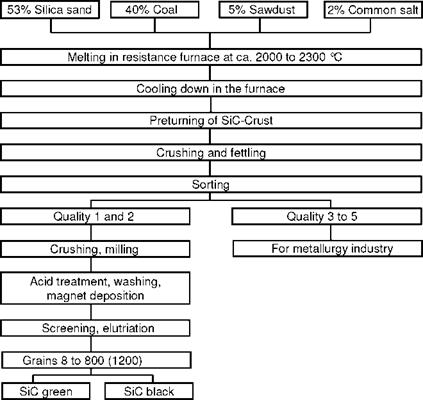Silicon carbide is a technical product that is melted from quartz sand in a resistance arc furnace. In this method, silicon carbides of varying purity, toughness and colour can be produced by altering the process, as is the case for corundum. Proceeding from the colour, we differentiate between green silicon carbide and black (dark) silicon carbide.
Manufacture
Silicon carbide utilised for abrasive applications is manufactured from a mixture of quartz sand, carbon, sawdust and common salt. The working steps illustrated in Fig. 3-9 are carried out in its production. The proportional amounts of these components in the furnace mixture correspond approximately to the stoichiometric ratio for the reactions executed in the production process [POCH62]:
SiO2 + 3C —— SiC + 2CO. (3.1)
Sawdust serves to loosen the mixture and thus to remove CO gases. Beyond this, the furnace mixture requires a small percent of common salt, which promotes the purification process by converting aluminium, iron and other impurities to their volatile chlorides [BABL67]. The melting process is carried out in temperatures of 2000 to 2400 °C in 5 to 20 meter-long furnaces and lasts about 36 hours.
After the mixture has cooled, its exterior zone is removed. In this layer, the reaction does not take place, and it therefore serves merely as a thermal isolation layer. Further inside, there is a zone of partially converted material made of SiO2, Si, C and SiC. After the removal of these layers, we come across the actual silicon carbide concentrically encircling the nerve, which has in the meantime turned to graphite. The finished product displays a solid, tubular crust baked together out of smaller and larger SiC crystals [BABL67]. This is crushed and freed of crude impurities, especially graphite. After cleaning follows the sorting of the raw material.
According to the positioning in the furnace, three to five quality levels are separated (Fig. 3-9), of which the first two undergo upgrading via a chemical — mechanical purification process. Qualities three to five are only mechanically purified. The latter are exploited in areas such as the metallurgical industry, where common impurities are not a problem.
After sorting, the SiC is crushed to a fineness of less than 3 mm in jaw crushers, roll crushers and impact crushers [BABL67]. The refinement of the product begins with acid treatment in order to dissolve any iron that may still be present. A second washing process removes the silicon and its compounds by means of a caustic soda solution. Finally, any graphite still present is separated with water and steam. After drying, the iron which was added in the conditioning process (crushing, rolling) is removed with a magnet separator. At the end, the grits are classified by sifting and sometimes also by sedimentation.
|
Fig. 3-9. The manufacture of silicon carbide |
Properties
The composition and properties of silicon carbide vary according to the type and proportion of impurities as well as the position in the furnace. Silicon carbide used for grinding is divided by colour into green and black silicon carbide. While the green colouration of 98 % SiC can be derived from quantities of nitrogen of 10-4 to 10-3 % [CELY54], small amounts of aluminium or aluminium oxide cause the blue to black colouration of the 97 % SiC variety [KONO65].
The Knoop hardness of silicon carbide is cited in the literature, independently of crystal orientation and the impurities present, as in the area of 2450 to 3000 HK [BABL67, COLL80, SPEN70]. As such, silicon carbide possesses the highest degree of hardness of all conventional abrasives.
Silicon carbide is a comparatively brittle grit material. Black silicon carbide exhibits more toughness than green silicon carbide in comminuting machines [GIES59]. Grit toughness is enhanced with increasing grit fineness (Fig. 3-5). The comparison between the temperature conductivity of silicon carbide and that of corundum shows that silicon carbide is capable of balancing temperature differences in the grit much better (Fig. 3-7). Since the thermal coefficient of expansion of SiC is relatively small, silicon carbide generally has a better temperature resistance than corundum. The pressure softening point is 2000 °C [BABL67]; at 2400 °C [COES71], the recrystallisation temperature is comparatively high.
Chemically, SiC is a very stable compound. It is also acid resistant at high temperatures. An exception to this is phosphoric acid, which already attacks finely powdered SiC at 200 to 300 °C. With temperatures between 1000 und 1600 °C, oxidation resistance is determined by diffusion processes. A continuous layer, consisting mostly of SiO2, acts against oxidation. There are numerous possible ways to increase the oxidation resistance of granular SiC. To these belong the reduction of the specific surface area and the selection of appropriate bonding materials.
Uses
SiC grinding wheels are predominately used in the rough-grinding and slitting of castings, carbides, aluminium, titanium and stone. However, SiC has lost a lot of its significance, because, especially in the case of glass and stone processing, many practices have been made more economical by synthetic diamond [JUCH86].

